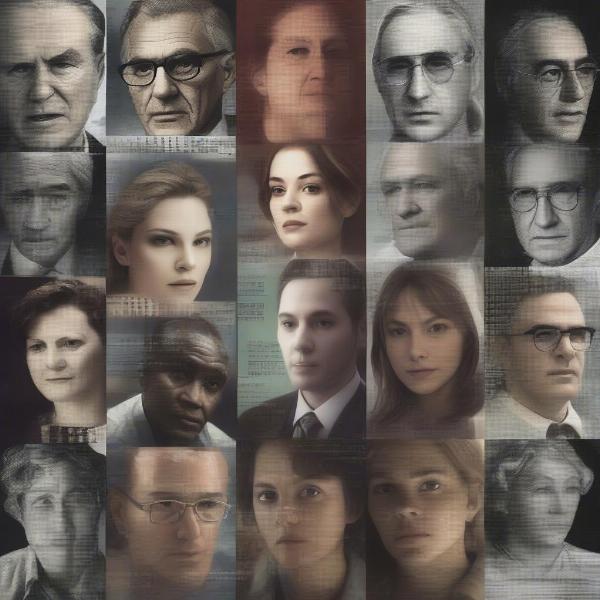The Westing Game, Ellen Raskin’s Newberry Award-winning mystery novel, captivates readers with its intricate plot and colorful cast of characters. But What Point Of View Is The Westing Game Told From? Understanding the narrative perspective is key to appreciating the book’s clever construction and unraveling its many secrets.
Unraveling the Narrative: Third-Person Omniscient
The Westing Game is told from a third-person omniscient point of view. This means the narrator is not a character in the story, but an all-knowing observer who has access to the thoughts, feelings, and motivations of multiple characters. The narrator can shift perspectives between different characters, revealing information that individual characters might not know themselves, creating suspense and dramatic irony. This allows readers to piece together clues alongside the characters, adding to the puzzle-solving element of the novel. Raskin expertly uses this point of view to control the flow of information, keeping readers guessing until the very end.
The Power of Perspective: How Omniscience Drives the Mystery
The third-person omniscient perspective is crucial to the success of The Westing Game’s mystery. By shifting between characters, the narrator can reveal clues and red herrings, creating a complex and engaging puzzle for the reader. We see the game unfold through the eyes of the various tenants of Sunset Towers, each with their own secrets and suspicions. This allows us to understand their individual motivations and biases, adding depth to the mystery.
Why Not First-Person?
Imagine if The Westing Game were told from the first-person perspective of just one character. We would only have access to their limited knowledge and perspective, making it much harder to appreciate the intricacies of the game. The mystery would be significantly less engaging, and the dramatic irony, a key element of the story, would be lost. The third-person omniscient perspective allows Raskin to create a more complex and satisfying puzzle.
 The Westing Game's Narrative Perspective: Third-Person Omniscient
The Westing Game's Narrative Perspective: Third-Person Omniscient
Examples of Omniscience in Action
The novel is full of examples where the omniscient narrator provides insights into the characters’ inner lives. For instance, we are privy to Turtle Wexler’s fear of the bomb, even as she puts on a brave face for the others. We also see the internal struggles of Theo Theodorakis, torn between his responsibilities to his family and his desire to pursue his own dreams.
The Clues are in the Details
The narrator also subtly reveals clues that the characters themselves might miss. This constant drip-feed of information keeps the reader engaged and actively participating in solving the mystery. The omniscient narrator acts as a guide, offering glimpses into the bigger picture while allowing the characters, and the readers, to slowly piece together the truth.
Inside the Minds of the Characters
One of the most compelling aspects of the third-person omniscient perspective is the access it grants us to the thoughts and feelings of multiple characters. This deep dive into their inner lives allows us to empathize with their struggles, understand their motivations, and appreciate the complexities of their relationships.
 Exploring the Inner Lives of The Westing Game Characters
Exploring the Inner Lives of The Westing Game Characters
The Westing Game and the Art of Misdirection
The omniscient narrator also plays a crucial role in misdirecting the reader. By providing access to the thoughts and suspicions of different characters, the narrator creates a web of red herrings and false leads. This keeps the reader guessing and adds to the suspense and excitement of the mystery. “It’s like a chess game,” observes fictional game expert, Grandmaster Anya Sharma, “where every move is carefully calculated to deceive the opponent.”
The Impact of Omniscience on the Reader’s Experience
The third-person omniscient point of view enhances the reader’s experience in several ways. It creates suspense by withholding information, encourages active participation in solving the mystery, and allows for a deeper understanding of the characters. “The beauty of Raskin’s narrative,” says literary critic, Dr. Julian Vance, “lies in its ability to keep the reader constantly guessing while simultaneously providing them with all the necessary clues to solve the puzzle.”
The Satisfaction of Discovery
By the end of the novel, the reader has a complete picture of the intricate game Sam Westing orchestrated. The third-person omniscient perspective allows us to see how each piece of the puzzle fits together, creating a satisfying sense of closure.
 Unraveling the Mystery: The Westing Game's Solution
Unraveling the Mystery: The Westing Game's Solution
Beyond the Game: Themes and Connections
While the mystery is the central focus of The Westing Game, the third-person omniscient perspective also allows Raskin to explore deeper themes of identity, community, and forgiveness.
Conclusion: A Masterclass in Narrative
The Westing Game’s use of the third-person omniscient point of view is a masterclass in narrative technique. It allows Raskin to create a complex and engaging mystery, while also exploring deeper themes and developing compelling characters. What point of view is The Westing Game told from? The answer is crucial to understanding and appreciating the brilliance of this enduring classic. Now, go reread The Westing Game and see if you can spot even more examples of Raskin’s masterful use of omniscience! Share your findings in the comments below.
FAQ
- What are some other books that use third-person omniscient? Many classic novels utilize this perspective, including works by Charles Dickens, Jane Austen, and George Eliot.
- Is third-person omniscient still used in modern literature? While less common than limited third-person, it is still employed by contemporary authors, particularly in fantasy and historical fiction.
- What are the advantages of using third-person omniscient? It provides a broader scope, allows for greater flexibility in revealing information, and can create dramatic irony.
- What are the disadvantages of using third-person omniscient? It can distance the reader from the characters and make the story feel less personal.
- How does third-person omniscient differ from third-person limited? Limited third-person restricts the narrator’s access to the thoughts and feelings of a single character.
- Why is point of view important in storytelling? Point of view shapes the reader’s experience, influencing how they perceive the story and connect with the characters.
- How does the point of view in The Westing Game contribute to its success as a mystery novel? The omniscient perspective allows Raskin to create a complex and layered mystery, while also providing insights into the characters’ motivations and relationships.

